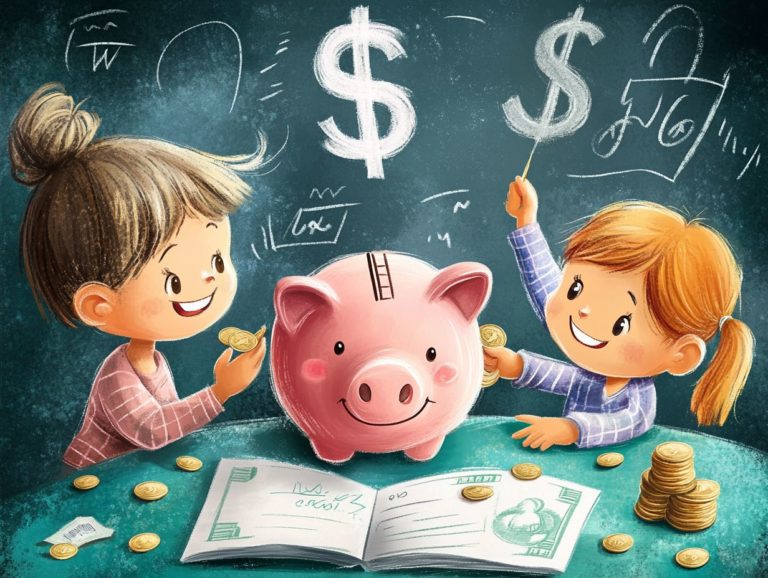How Do Allowances Teach Kids Financial Responsibility?

Neale Godfrey is the financial voice for women and multi-generations and a world-renowned speaker and author, who has inspired millions through her work. She motivates, trains, educates, and frankly, entertains by delivering her core message: Empower yourself to take control of your financial life.
Allowance It’s not just pocket money; it’s a key tool that helps kids learn important money-handling skills.
Allowances serve various purposes, and the amount parents should consider giving can vary.
Giving allowances has many advantages, such as encouraging financial responsibility and good saving habits, while there can also be potential downsides like entitlement and unhealthy spending.
Practical tips on how parents can effectively use allowances, along with alternative methods to teach financial literacy, will be discussed.
Key Takeaways:
What Are Allowances?

Allowances help kids learn about handling money, being financially responsible, and budgeting from an early age. By setting up a regular allowance, parents can teach their children how to earn, save, and donate, which supports their early learning about being financially independent.
This method can be used in daily life through chores, teaching kids how to make money and value it. Psychology Today discusses whether giving kids an allowance can significantly influence their spending habits and knowledge about money. For those looking to enhance their approach, the [Allowance Management: Techniques and Benefits for Kids](https://breadbox.money/kids-finance-education-platform/financial-literacy/allowance-management-techniques/) offers practical strategies. Eventually, allowances offer teaching opportunities that can strongly influence kids’ spending habits and knowledge about money.
What Is the Purpose of Giving Allowances to Kids?
Giving kids allowances teaches them how to manage money. It teaches them how to manage money wisely, build smart spending habits, and understand the need to plan and save for later.
When parents discuss financial goals and expectations with their children, kids learn to make wise decisions with their money and become more independent in handling their finances. For further guidance, consider these tips on how to teach kids to save and track money, which can be incredibly useful in fostering financial responsibility.
How Much Should Parents Give as Allowances?
Figuring out how much allowance to give depends on a few things like the child’s age, their duties, and what the family can afford.
A good allowance should teach kids about handling money and fit with the budgeting habits parents want to teach. It’s key to find a balance that helps kids learn how to manage money, gain some financial freedom, and understand what money stands for. For those interested in a comprehensive overview, this guide by Capital One offers insightful tips on managing allowances effectively.
What Factors Should Be Considered When Deciding Allowance Amount?
When determining how much allowance to give, think about the child’s age, family expenses, and personal spending habits. It’s important to consider how the allowance will be used when planning a budget. This helps children understand the need to balance different costs and make wise choices with their money.
Knowing what children should do at different ages is important, as younger children often need more help with budgeting than their older brothers and sisters.
A family’s income can influence how an allowance is framed, promoting discussions about financial priorities and needs versus wants.
By using budgeting exercises suited to their financial situations, parents can make these lessons more meaningful, helping their children understand the real-world effects of handling money.
Learning these essential skills helps them manage upcoming costs confidently and builds a sense of responsibility that will be useful as they mature.
What Are the Benefits of Giving Allowances to Kids?
Giving kids pocket money has many advantages, such as teaching them to manage money and learn important financial skills.
Children who receive pocket money learn to manage their money, save, and make wise choices, which helps them become financially self-sufficient. This approach is supported by Edutopia, which emphasizes that teaching financial literacy yields significant long-term benefits.
These lasting benefits help children manage money wisely, teach them to save, and show them why money matters in daily life. For practical allowance management techniques that can enhance these skills, parents can explore various methods (our guide on allowance management techniques offers valuable insights).
1. Teaches Financial Responsibility

Giving kids a regular amount of money helps teach them about handling money wisely, encouraging them to learn the importance of managing finances. When children are given a set amount of money, they learn to choose wisely how they spend it, helping them to plan for later costs and manage their own money.
For instance, when a child receives a weekly allowance, they face choices regarding whether to save for a desired toy, spend on a treat, or donate to charity.
This decision-making process helps them compare immediate benefits with long-term objectives, teaching skills like budgeting and planning ahead.
As they go through their options, they start to understand the value of waiting for rewards and the effects of spending too much, which helps them develop better money habits.
Learning how income and expenses work when you’re young helps you make good financial decisions later on.
2. Encourages Good Saving Habits
Allowances encourage good saving habits by providing kids with the opportunity to set and achieve savings goals. When kids handle their allowance, they learn to save part of their money for later, helping them build good money habits.
To improve this learning experience, parents can use visual tools like charts or jars to show how savings are growing. Such tools make accomplishments tangible and allow children to visualize their goals.
Turning saving into a fun activity can encourage kids to save better. For example, giving rewards when they reach certain goals can create a feeling of success and challenge.
Setting clear, reachable savings goals for things they really want helps children remain interested and involved in learning about money, turning allowances into strong learning experiences.
3. Provides a Sense of Ownership and Control
Providing an allowance instills a sense of ownership and control in children regarding their finances, allowing them to make independent spending choices. This independence helps them become truly interested in learning about different spending habits and how their money choices affect them, ultimately preparing them for adult life.
When children are responsible for handling their own money, they learn the difference between saving and spending, which can greatly affect their ability to make choices.
This experience serves as a practical lesson in budgeting, enabling them to prioritize their needs and wants effectively.
As they go through these financial challenges, they better understand how their decisions affect their money and long-term plans.
This responsibility builds confidence and teaches important life skills that will help them manage more difficult money tasks when they are teenagers and adults.
4. Teaches Budgeting Skills
Receiving an allowance is an excellent introduction for kids to learn budgeting skills, as it allows them to allocate their funds towards various wants and needs. By guiding children in managing their finances, parents can help them understand how to create a budget that reflects their spending decisions and personal financial goals.
One effective method is to encourage children to track their expenses using simple tools like a notebook or budgeting app. This approach helps people notice where they spend their money and shows common trends in their spending.
Teaching children about making choices is important. For example, if a child wants to save for a toy, they might need to give up small daily snacks. Teaching the importance of saving helps children learn to wait for rewards, creating a solid base for managing money as they grow up.
5. Helps Kids Understand the Value of Money
Allowances help kids learn the value of money by letting them make financial choices. By managing their own funds, children develop a deeper appreciation for the effort required to earn money and the importance of spending wisely within their financial boundaries.
When children receive a set allowance, they are confronted with choices that require planning and thoughtful consideration. For instance, deciding between saving for a desired toy or spending on instant gratification teaches them the importance of budgeting.
By tracking their expenses, they learn to tell the difference between essentials and extras, building responsible money habits early on. These experiences show children how to handle money and help them make better choices as they grow, laying the foundation for good money habits as adults.
What Are the Potential Downsides of Giving Allowances to Kids?

Allowances can be helpful, but parents should be aware of some possible downsides, such as kids feeling too entitled.
This can lead to bad spending habits and cause arguments between parents and kids about managing money and what is expected. For those interested in exploring solutions, the concept of allowance management techniques offers valuable insights into balancing generosity with responsibility.
1. May Create a Sense of Entitlement
One possible issue with giving allowances is that it might lead kids to feel they deserve money simply because they’re given it, rather than recognizing the effort or responsibilities involved. This can undermine the lessons of financial responsibility that allowances are meant to teach.
When children perceive money as a right rather than a privilege, they may fail to grasp essential financial concepts such as budgeting, saving, and earning. This way of thinking can result in seeing money as easy to get, which means they might not understand its worth.
Over time, if they do not learn to connect money with effort and responsibility, their relationship with finances may become superficial, increasing the risk of impulsive spending and poor money management.
Teaching children to be responsible early on can greatly influence their money habits and views as they grow up.
2. Can Lead to Unhealthy Spending Habits
Another downside of allowances is that they can lead to unhealthy spending habits if not supervised properly. Kids might choose to use their money immediately instead of keeping it for future needs, which can impact their ability to make good financial decisions.
Without effective parental guidance, children may struggle to differentiate between needs and wants, often leading to impulsive buys that can extend into adulthood. This situation can create a cycle of poor financial management, which may perpetuate over time.
To address this problem, parents need to talk openly about managing money and why saving is important. Teaching financial literacy can be more effective by using common situations like shopping for groceries or putting money aside for a toy.
Parents can help their children feel sure of themselves when deciding how to spend money later by showing them how to manage money sensibly.
3. May Cause Conflicts between Parents and Kids
Allowance discussions can sometimes lead to conflicts between parents and kids, particularly regarding financial expectations and the relationship between chores and allowance. Clear communication helps avoid misunderstandings and ensures that both parties agree on their financial responsibilities and roles.
When conflicts happen, parents and children should share their views openly without blaming each other. Talking openly about why certain expectations exist can help people understand each other better.
For instance, children may feel entitled to an allowance regardless of their participation in household chores, while parents might believe that contributions to the family responsibilities should be rewarded financially.
Actively listening to each other’s viewpoints can pave the way for a collaborative approach, ensuring that values around effort and financial literacy are instilled from an early age.
Creating agreed guidelines can help maintain a peaceful agreement and improve family relationships.
How Can Parents Use Allowances to Teach Financial Responsibility?
Parents can use allowances to show kids how to handle money by setting clear guidelines and discussing financial matters.
By explaining the reason for the allowance and how it’s connected to their chores, children understand the link between work and earning, helping them develop good money habits.
1. Set Expectations and Rules

It is important to set clear guidelines and rules about allowances to teach children how to manage money. By establishing guidelines for how the allowance can be spent, saved, or donated, parents can create a structured approach to money management that promotes responsible financial behavior.
To make this concept clearer, parents can keep track of spending and saving by using a simple spreadsheet or a money app designed for children. Encouraging children to log their transactions helps them visualize their decisions and develop accountability.
Discussing goals, like saving for a desired toy or game, makes the process engaging and practical. Regular family meetings can help review these goals, see progress, and update rules as needed, making sure children feel involved and assured in handling money.
2. Encourage Savings and Budgeting
Teaching kids to save and budget by giving them allowances can greatly help them learn how to handle money. When parents teach kids to save part of their allowance, they help them learn how to plan and make good money decisions.
This process can be made even more engaging by introducing visual progress tracking systems, such as charts or jars that display how much they’ve saved over time.
Gamifying the savings experience can motivate children to meet their goals by offering small rewards or challenges. For example, creating friendly competitions with siblings or friends can turn saving into an enjoyable activity rather than a chore.
Explaining these methods helps parents demonstrate to kids how to handle money wisely and promotes a good attitude toward money management early in life.
3. Discuss Financial Decisions with Kids
Talking to children about money can turn allowance into helpful lessons. By involving children in conversations around spending, saving, and budgeting, parents can help them develop critical thinking skills related to money management and financial literacy.
A practical way is to use examples from daily life, such as planning a family trip or budgeting for a birthday party. Parents can include their children in deciding how to spend money on different activities, teaching them the importance of setting priorities and making wise choices.
Games that mimic money scenarios, such as Monopoly or online budgeting apps for children, can help them learn how to handle finances better. By developing interesting and meaningful activities, they can start helpful conversations about money that inspire curiosity and build confidence in making wise financial choices.
4. Use Allowances as a Teaching Tool
Utilizing allowances as a teaching tool allows parents to impart lessons on financial responsibility while providing a hands-on approach to money management. This plan helps children learn financial ideas by letting them practice directly.
By introducing children to budgeting practices, parents can encourage them to allocate a portion of their allowance for savings, spending, and contributions to charitable causes.
For instance, setting aside a specific amount for charity can instill values of generosity and social awareness. Parents can engage kids in discussions about the importance of delayed gratification by helping them plan for larger purchases instead of impulse buys.
By using different methods, allowances turn into important lessons about managing money, influencing their views on finances and building habits that help them as grown-ups.
What Are Some Alternatives to Traditional Allowances?
There are different ways to teach kids about handling money and being responsible, aside from giving them a set allowance.
Ideas like paying them for doing chores, setting up a budget instead of a fixed allowance, or letting them earn money through small business ventures offer special ways to learn about finances. For further insights into how these strategies compare, explore our detailed discussion on Allowance vs. Rewards: Differences and Best Practices for U.S. Families.
1. Pay for Chores
Paying for chores provides a direct link between work and earning money, reinforcing financial responsibility in children. By compensating kids for completing household tasks, parents create teaching opportunities that highlight the value of hard work and responsible money management.
This method can strongly encourage children to take a more active role in their tasks, helping them feel proud as they receive rewards for their work.
It is a useful lesson in managing money, including planning, saving, and spending, which can help them make financial choices later on.
Children could begin to expect payment for every task, which might hurt their innate motivation to act independently.
It’s important to find a balance; while money can encourage them to begin helping, it’s equally necessary to create genuine responsibility and participation in the household for their development.
2. Use a ‘Spending Plan’ Instead of Allowances
Implementing a ‘spending plan’ instead of a traditional allowance allows families to tailor financial education to their children’s specific needs and aspirations. This approach helps kids learn how to create and manage a budget, encouraging them to become financially independent by handling their own money.
By using a spending plan, families can divide their expenses into categories like savings, entertainment, and education. This offers a practical view on managing money.
For example, a child may receive a monthly budget that includes earmarked funds for both saving towards a desired toy and spending on outings with friends. This system helps kids learn to manage money wisely and understand the importance of organizing their spending.
As they make choices, they understand why money matters and the importance of planning for both short-term fun and long-term goals, which helps them become adults who know more about managing money.
3. Allow Kids to Earn Money Through Entrepreneurial Activities
Encouraging kids to earn money through starting their own small businesses teaches them about handling money and also helps them think creatively and take action. By starting small businesses, children learn important skills for handling money and get practical experience in real-life situations.
These activities can range from setting up a lemonade stand to offering lawn care services, enabling kids to understand the concept of supply and demand firsthand.
Such experiences allow them to keep track of expenses, pricing, and profits, which are essential components of financial literacy. Participating in community markets or school fundraisers provides a platform for them to develop social skills and build confidence.
As they handle issues such as customer service and competition, they develop problem-solving skills that help in many areas of life.
These business activities teach children useful skills and help them develop responsibility and a positive approach to managing money in the years ahead.

Neale Godfrey is the financial voice for women and multi-generations and a world-renowned speaker and author, who has inspired millions through her work. She motivates, trains, educates, and frankly, entertains by delivering her core message: Empower yourself to take control of your financial life.






